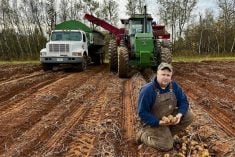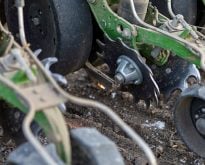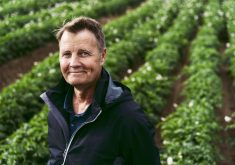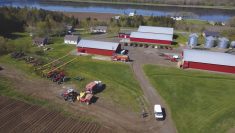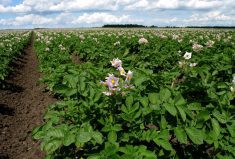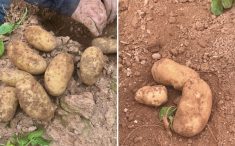Every farmer knows that change is inevitable. New markets beckon, new technologies emerge, end-user tastes, preferences and opportunities shift, and it’s often the primary producer who’s one of the first to react.
Peter VanderZaag has spent much of his farming career investing wisely in new equipment, securing contracts and growing his Sunrise Potato Storage business in Alliston, Ont., to where it is today. But VanderZaag’s journey required a firm and ongoing commitment to change, first in terms of soil health and productivity, and then in meeting his customers’ demands for quality and consistency while incorporating new technologies. Given his starting point, the changes were neither quick nor simple.
“Most farmers understand they have to do this,” says VanderZaag, who grew up on a family farm near Alliston in the 1950s. “You cannot get a mediocre crop — you need an excellent crop. You have to have everything done right, and that starts with good soil health and good soil management … and then good seed and good management of the crop as it grows.”
Read Also

Farmland values: assumptions and realities
Where farmland values are headed and what decisions farmers should make
As a child helping out on a farm which included cows, hogs and potato, grain and hay production, VanderZaag says he learned the value of diverse cropping practices. Sustainability was possible, even with 100 acres.
However, from 1963 to 1980 there was significant expansion of monoculture potato production in southern Simcoe County where the farm was located. VanderZaag says diverse crop rotations and livestock production were abandoned across much of the district and soils began to show signs of deleterious pathogen levels as well as water and wind erosion, with frequent sandstorms in the area. Then interest rates spiked in the early 1980s and farm productivity collapsed, he adds, and numerous producers in the region abandoned potatoes altogether following a disastrous growing season in 1986.
VanderZaag eventually became a potato scientist, and in 1991 he and his wife Carla returned to Canada after living abroad for decades. The couple set their sights on potato production and leased several abandoned farms in an area north of where VanderZaag grew up.
Seeing the impact of soil degradation in many parts of the world, the VanderZaags realized soil heath and crop diversity would be key to their farming success and they could also serve as an example for others to consider. They embarked on a 16-year journey in returning the soils on their farms to full productivity, employing many of the regenerative agricultural practices they had learned from their travels.
Three of the farms the VanderZaags rented and later purchased couldn’t sustain barley production the first season, while four rented farms still had potato ridges left from previous years, with volunteer trees growing in some spots. Their first two measures were to install some tile drainage and then secure an agreement with a local beef producer for liquid manure to be applied annually to the fields. Other measures included adding irrigation to fields and selective seeding of cover crops on less productive areas, as well as variable rate applications of potassium, lime and gypsum.
READ MORE: Where did potato production land in 2022?
Doing more with less
VanderZaag, whose daughter Ruth and son-in-law Nick Ploeg now play a leading role as farming partners, says in spite of high fertilizer and fuel prices and increasing demands from processors for supply, quality and consistency, Sunrise has managed to “do more with less” — a common refrain in agriculture these days.

“With potatoes we use more fertilizer and more diesel fuel than most (crops) per acre of land,” he says. “We bought a lot of our fertilizer last year before the prices went up. Whatever we could pre-order and pay for, we did, and that helped to some extent. But … we couldn’t order (fuel) in advance and then nitrogen costs went up, so it all adds up.”
VanderZaag says having contracts with three chipping processors with plants in both Canada and the United States and also some timely investments in equipment have enabled Sunrise to weather some of the cost volatility of late.
About six years ago the farm invested in a Tomra optical sorting system, which VanderZaag says cuts down on labour required for sorting and also lessens the chance of reduced quality or a loss of confidence by their buyers, the processors.
“If you don’t have that system, your potatoes may be considered of inferior quality at the plant because they’re not as clean, not as well sorted,” he says. “If you find a walnut in your potatoes, for example, you’re in trouble. Those are all things that have now become an issue.”
For VanderZaag, the 2023 potato season brings a blend of optimism and caution. In spite of forecasts of a recession, he says, economic downturns can have an interesting benefit — consumers increase their chip purchases during harder financial times. There’s also the Canadian dollar’s relative weakness compared to the U.S. dollar, which becomes a substantial advantage for shipping potatoes south of the border.
“Our problem is that demand exceeds our supply, both locally and to the northeastern United States,” says VanderZaag. “Brokers like W.D. Potato (potato wholesaler) want more potatoes because they can’t fill contracts, or they want bigger contracts. That’s something in our favour, but the flip side is to buy a new digger or windrower or a tractor, the prices are through the roof.”
Added to that is the impact of interest rate hikes. “I hope it’s not like the ’80s with 18 per cent interest,” says VanderZaag. “My father told me when I came back to the farm, ‘Don’t spend a dollar unless you have a dollar’ because he’d gone through the ’80s. We have to be very careful not to spend too much money because that interest eats you up pretty quick.
– This article was originally published in the 2023 edition of the Potato Guide.




